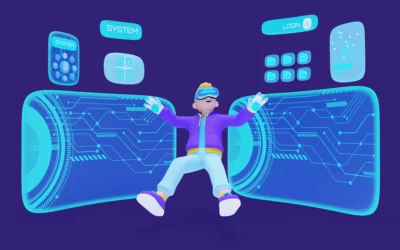Introduction
In an era where digital landscapes evolve at an unprecedented pace, the symbiotic relationship between software development and cybersecurity has never been more critical. As technology advances, so do the threats that loom in the digital shadows.
In this blog post, we will explore the current cybersecurity trends shaping the landscape of software development.
Zero Trust Architecture: Redefining Security Perimeters
Traditional security models built on the assumption of trust within a network are giving way to the Zero Trust Architecture. This paradigm shift emphasizes strict identity verification for every person and device, regardless of their location in the network. We’ll delve into how this approach enhances security in software systems.
By adopting Zero Trust Architecture, organizations can bolster their defenses against an ever-evolving threat landscape. The model aligns with the modern reality of dispersed and dynamic work environments, where users access resources from various locations and devices. Zero Trust not only enhances security but also promotes a proactive and adaptable approach to cybersecurity, aligning organizations with the imperative of safeguarding digital assets in an interconnected world.
DevSecOps: Integrating Security into DevOps Practices
The integration of Development, Security, and Operations (DevSecOps) is transforming the software development lifecycle. We’ll explore how embedding security practices at every stage of development not only fortifies applications against cyber threats but also ensures a more agile and resilient development process.
In the fast-paced landscape of software development, the traditional approach of treating security as an isolated and final step in the process has become outdated. Enter DevSecOps, a cultural and technical movement that advocates for the seamless integration of security practices into the DevOps pipeline. This shift represents a fundamental change in mindset, recognizing that security is not a roadblock but an integral aspect of the entire development lifecycle.
Artificial Intelligence (AI) for Threat Detection
As cyber threats become more sophisticated, so too must our defense mechanisms. AI plays a pivotal role in identifying patterns and anomalies that human-centric approaches might overlook. We’ll discuss the integration of AI-driven threat detection solutions in software development.
The integration of AI in threat detection marks a transformative chapter in cybersecurity. By harnessing the power of machine learning, behavioral analytics, and predictive capabilities, organizations can fortify their defenses against a wide array of cyber threats, fostering a more resilient and adaptive security posture.
Container Security: Safeguarding Microservices Architectures
Microservices architectures bring agility but also introduce new security challenges. We’ll delve into the best practices and tools for securing containerized applications, ensuring that the benefits of microservices are not compromised by vulnerabilities.
Container security is integral to the success of microservices architectures. Embracing security at every stage of the container lifecycle, from image creation to runtime monitoring, enables organizations to harness the benefits of containers without compromising on security. As microservices continue to shape the software landscape, robust container security practices will be fundamental to building resilient and secure applications.
Secure Coding Practices: Building a Robust First Line of Defense
The foundation of software security lies in the code itself. We’ll explore secure coding practices, from input validation to proper error handling, that developers can adopt to create resilient software that stands strong against common vulnerabilities.
Secure coding practices are foundational to building resilient and trustworthy software. By adhering to these principles, development teams can significantly reduce the risk of security breaches and create robust applications that stand up to the challenges of the digital landscape. As the threat landscape evolves, ongoing education and adaptation of secure coding practices remain essential for maintaining a strong defense against cyber threats.
Ransomware Resilience: Planning for the Worst
Ransomware attacks have become more prevalent and sophisticated. We’ll discuss strategies for developing software with built-in resilience against ransomware, including secure data backup and recovery mechanisms.
Ransomware resilience planning is not a luxury but a necessity in today’s cyber threat landscape. Organizations must adopt a multi-faceted approach that encompasses technology, user awareness, legal considerations, and collaboration with law enforcement. By preparing for the worst-case scenario, organizations can fortify their defenses and respond effectively to ransomware threats, ultimately minimizing the impact on their operations and safeguarding their valuable data.
Continuous Security Auditing: Maintaining Vigilance
Security is not a one-time affair. Continuous security auditing is becoming a standard practice in software development. We’ll explore how regular audits and penetration testing contribute to identifying and addressing vulnerabilities proactively.
Continuous security auditing represents a paradigm shift from conventional auditing approaches. It aligns with the dynamic nature of cybersecurity threats and emphasizes the importance of real-time monitoring, adaptability, and proactive risk management. By embracing continuous security auditing, organizations can fortify their defenses, respond agilely to emerging threats, and maintain a robust security posture in the face of evolving challenges.
Blockchain for Security: Beyond Cryptocurrencies
Beyond cryptocurrencies, blockchain technology offers a decentralized and tamper-resistant framework. We’ll explore how integrating blockchain can enhance the security of software systems, especially in areas like identity verification and data integrity.
Blockchain technology has evolved into a potent tool for enhancing cybersecurity and fortifying data security practices. Beyond its role in cryptocurrencies, blockchain’s decentralized, transparent, and immutable attributes provide innovative solutions to the multifaceted challenges posed by an increasingly digital and interconnected world. As organizations continue to explore the potential of blockchain, its transformative impact on security practices is poised to reshape the foundations of digital trust and resilience.
Conclusion:
In this blog post, we aim to provide insights into the evolving realm of cybersecurity within the software development landscape. Developers and organizations can fortify their digital assets by understanding and adopting these trends and contribute to a more secure online ecosystem. Stay tuned for a deep dive into each of these trends, empowering you to navigate the complex digital frontier with confidence.





